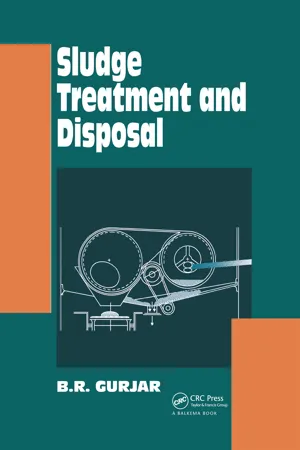1.1 Introduction
As far as the public is concerned, sludge is a dirty word, usually associated with pollution, contamination and disease. It is considered universally as a waste, something to be disposed off out of sight and out of mind. Nobody wants it in his backyard, but, elsewhere.
Sludge can be defined as a soft mud or mire, a slimy precipitate produced from sewage. As far as an environmental engineer is concerned, sludge is a by-product from several sources. These sources [3, 5] are as follows:
• water treatment plants
• sewage treatment plants
• dredging of rivers and harbours
• coal and sand washeries
• industrial manufacturing, and
• agriculture
Sludge can be visualized as consisting of particles aggregated into floes that act hydro-dynamically as single particles. These floes can be in suspension without touching other floes (e.g. alum floe in water treatment prior to settling) or in a solid matrix where individual floes cannot be identified and the sludge mass forms a continuum (e.g. waste-activated sludge).
As far as quantity of sludge is concerned, overall sludge production is dependent on influent loading, type of treatment, treatment performance, type of sludge handling facilities, and effluent treatment requirements. In general, sludge production is expected to be directly related to the average dry weather flow rate through the plant, assuming no changes in influent unit loading or treatment process.
1.2 Nature and Scope [7, 8, 9, 10, 11]
Is sludge purely a waste? Can it serve as a resource? These questions require discriminating definitions of the terms waste and resources. Obviously, waste can be defined as something which is lying unused, unproductive, uncultivated, superfluous, or which is in disadvantageous (useless) condition. On the other hand, resource is a means of raising wealth or money, i.e. something which can be used in one or more way, or a thing out of which some useful by-product can be extracted, or something with the help of which some advantageous product/item can be manufactured. Clearly from such general definition, all forms of sludge that are put to use are not a waste, but those that are just dumped most certainly are.
(i) Water treatment sludge: In case of water treatment plants, sludge comprises settled particulate matter in sedimentation tanks, flocculated and precipitated material resulting from chemical coagulation, or residuals of excess chemical dosage, plankton, etc. In this case, for continuous sludge removal, the feasibility of discharging of sludge to existing sewers nearby is normally considered. For lime softening plant sludge, the reclamation by calcining and reuse can be explored. Sludge from clarification units using iron and aluminium coagulants can be dewatered to a cake by vacuum filtration using lime as the conditioner, that can conveniently be trucked for landfill. Recovery of alum from sludge by treatment with sulphuric acid offers possibilities of reducing the quantity of sludge to be handled. Sand drying beds are an acceptable method for dewatering certain types of sludge from settling tanks or clarifiers for further disposal by landfill. Simple lagooning of sludge does bring about a reduction in the bulk of the sludge to be handled and further disposal as landfill. However, acceptable application rates for water treatment sludges to various soil types are related to phosphorus fixation capacity of the sludge.
(ii) Sewage sludge: Sewage sludge is a slurry with water content usually in excess of 95 %. The solid phase consists principally of organic matter, derived from human, animal and food wastes. Other constituents are trace contaminants (metals and persistent organic compounds) mainly from industrial effluents and bacteria, some of which may be pathogenic.
Girovich [8] describes the sewage sludge in its initial form as a liquid with 2–6 % total solids (TS). On a dry basis, sludge contains 35–65 % of organic matter, with the remainder being mineral noncombustible ash.
Nutrients like nitrogen, phosphorus, potassium and some trace metals are present in sludge and can be used as an effective fertilizer. The sludge also contains pathogens, and, in some cases, constituents such as heavy metals and hazardous organics.
1.3 Properties of Sludge [4, 12, 13, 14]
Just as every treatment plant is different, the sludge produced at each plant is different. The different forms of sludge e.g. agricultural, dredging, sewage, etc. contain different constituents and different concentrations of pollutants. The major component of sludge is water, up to 95 % by weight. The remaining dry solids contain variable proportions of nitrogen, phosphorus, potassium, heavy metals, pathogens, polychlorinated biphenyls (PCBs) and other constituents depending on the source of the sludge.
Sludge may be distinguished by its physical, chemical, bacteriological and biological properties. These properties or characteristics depend on the nature of origin or source from which the sludge is obtained, and unit operations and processes by which it is produced.
1.3.1 Physical Properties
The physical properties of sludge determine, to a great extent, the possibilities and conditions of digestion and disposal of sludge. The most important physical properties are given below:
(i) Colour and odour: Fresh sludge from municipal wastewater is light-grayish or yellowish. Fully digested sludge is black (due to iron sulphides) and has a tarry odour. Sludge produced by aerobic digestion is brown and has a humus-like odour. It can be air dried in about two weeks with no odour release in normal dry weather.
(ii) Water content: The volume of sludge depends mainly on its water content and only slightly on the character of the solid matter. A 10 % solids in sludge, for example, contains 90% water by mass. If the solid matter is composed of fixed (mineral) solids and volatile (organic) solids, the specific gravity of all of the s...

